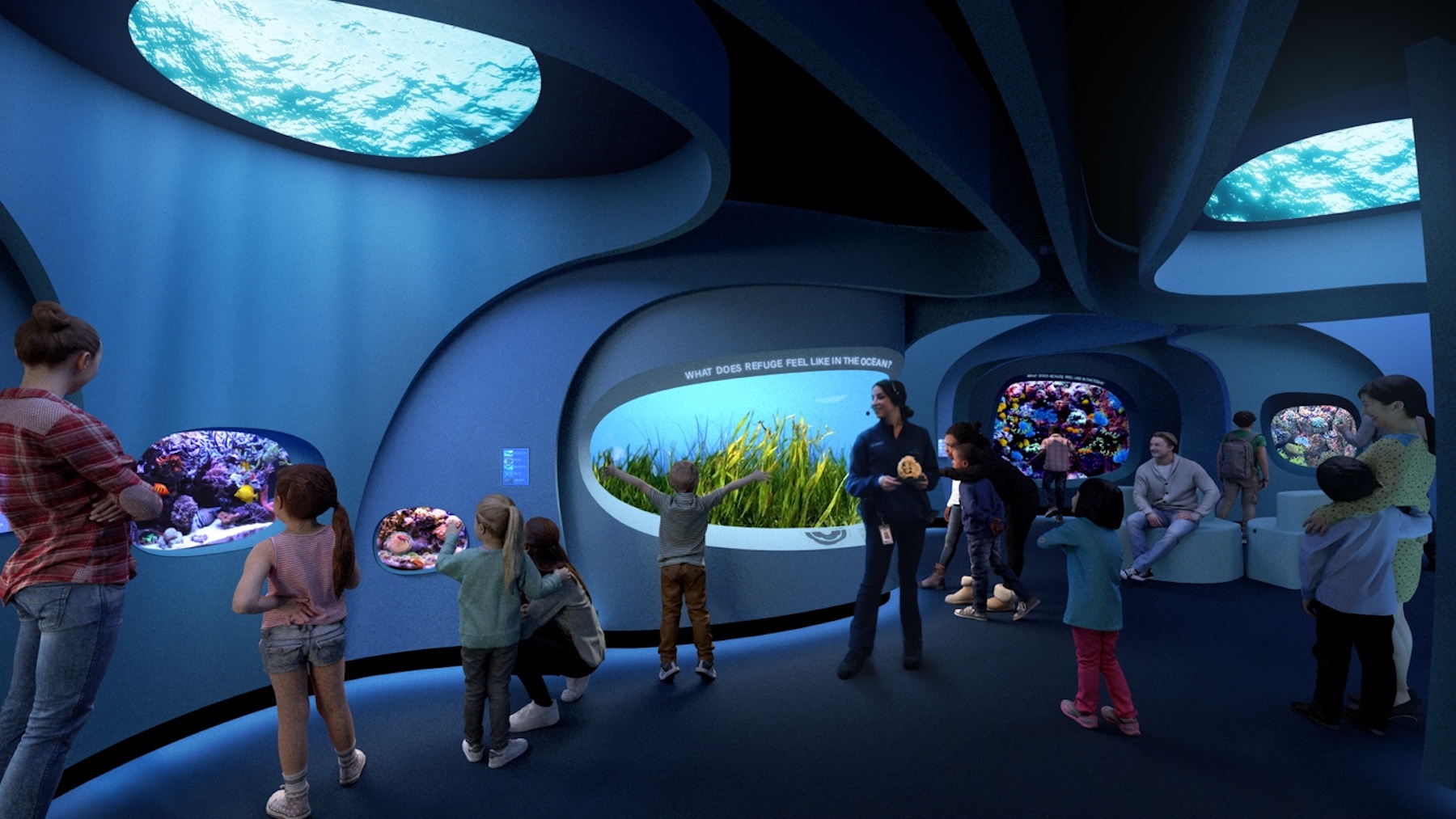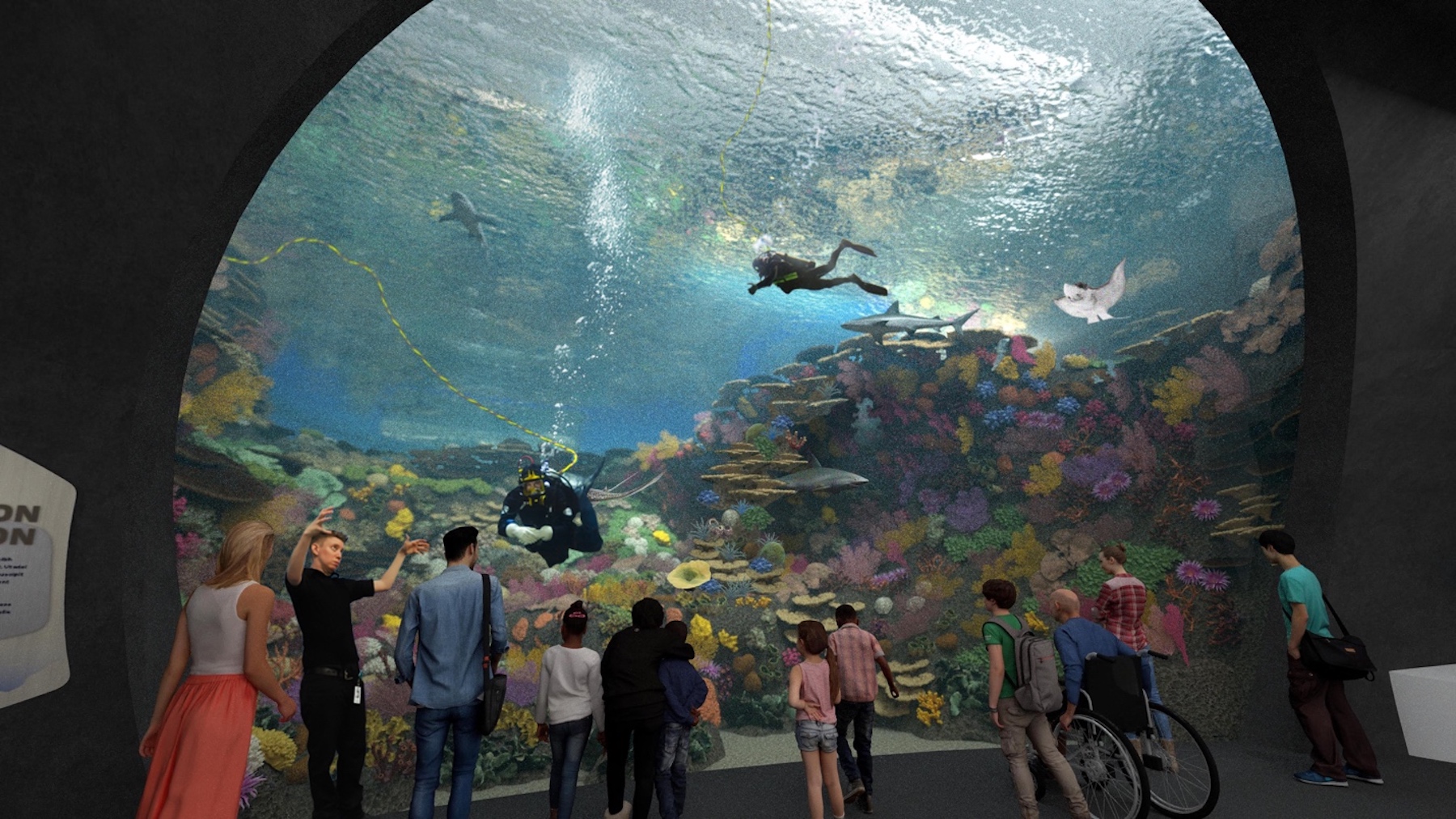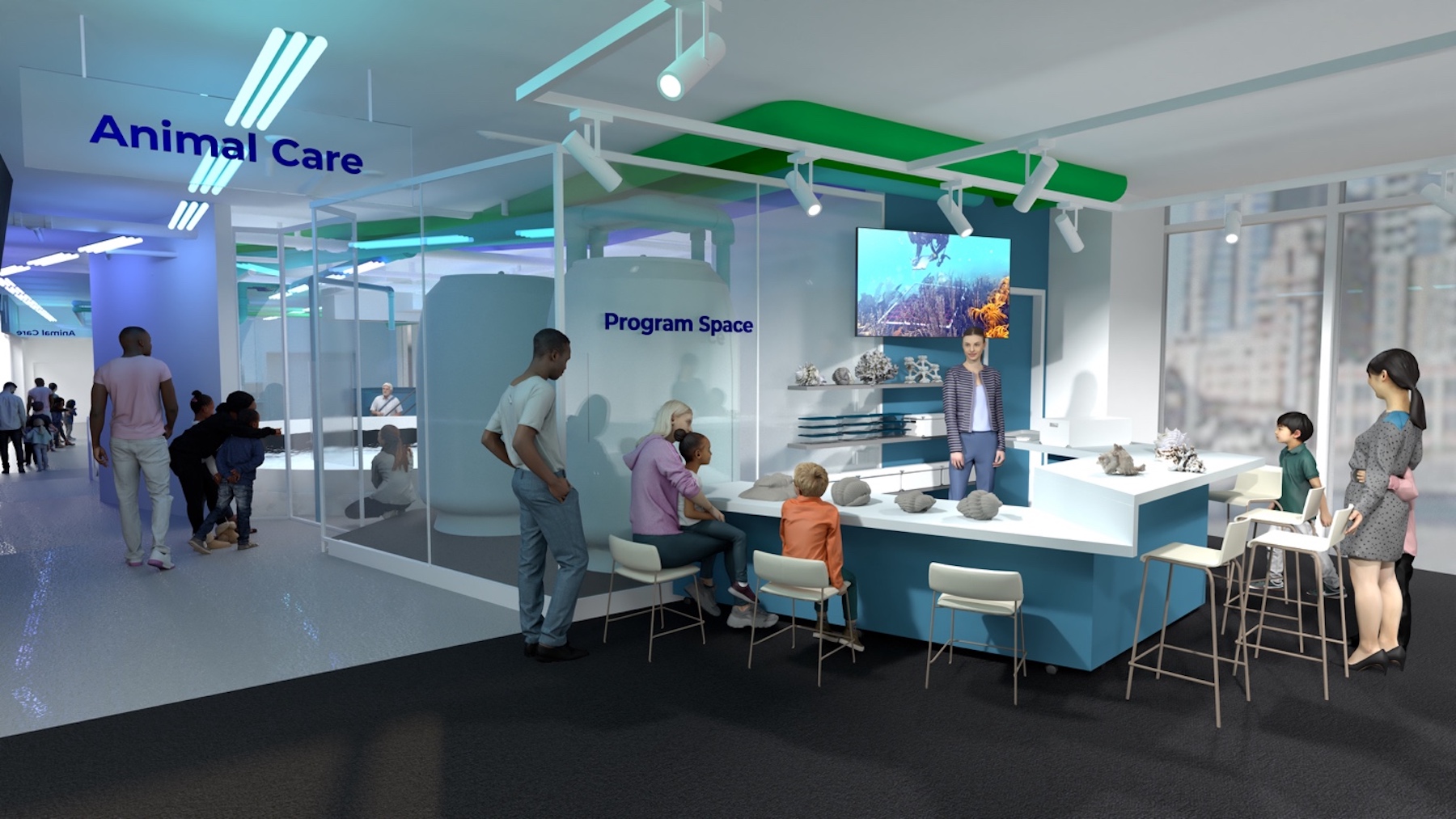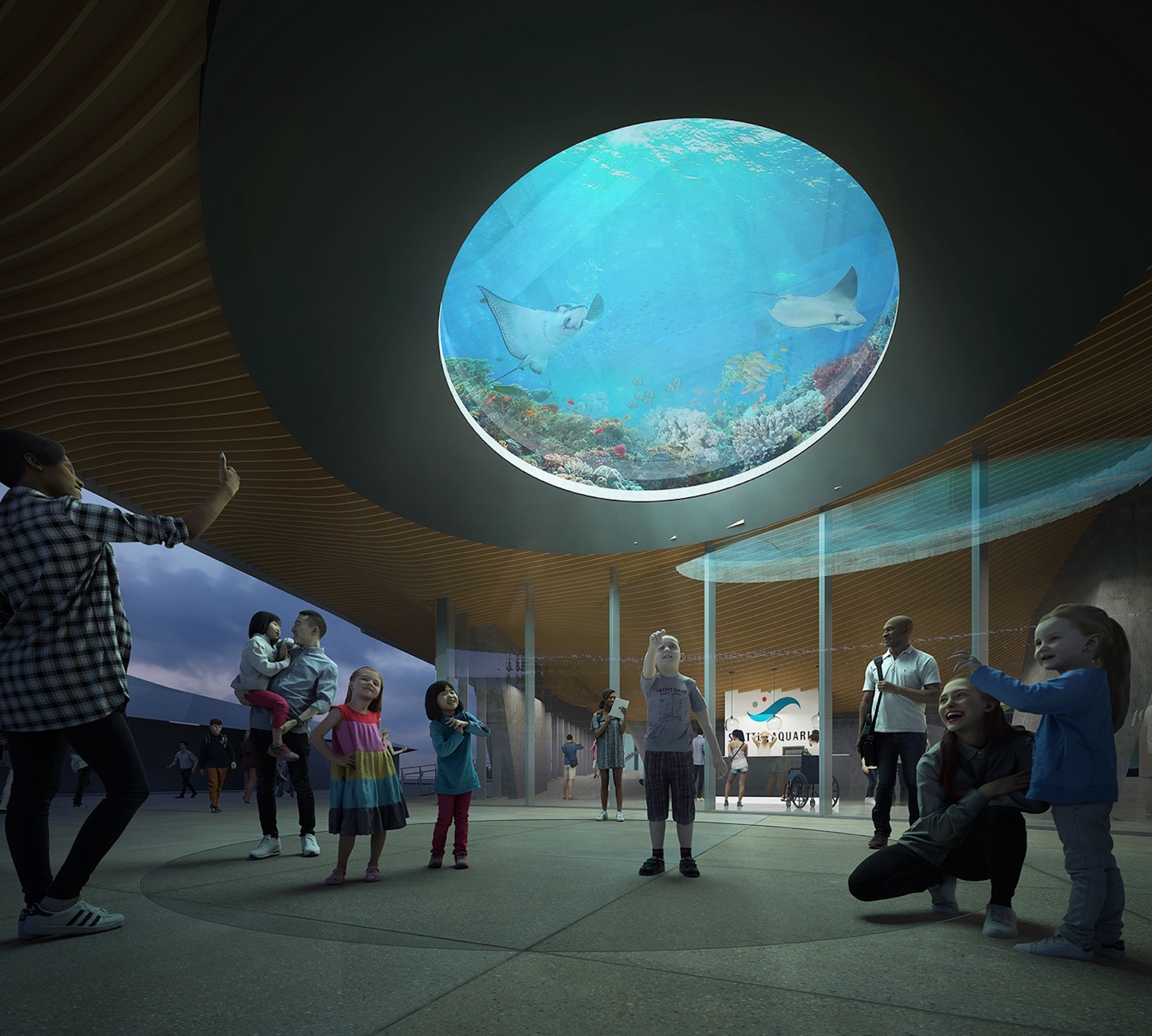Seattle Aquarium’s new Ocean Pavilion, currently under construction, features several exhibits that examine the human connection with the Earth’s oceans. The 49,000 sf Ocean Pavilion has 19 living exhibits organized around The Reef, a new 362,000 gallon, two-story living habitat that is visible from five unique perspectives.
The Reef depicts a biodiverse Coral Triangle reef community, featuring an expansive, nearly 30-foot-wide domed view on the ground floor and additional viewing windows on an upper gallery. Cantilevered over the Pavilion’s entrance, it also features the “oculus”—a 16-foot wide portal that allows passersby to stand beneath and view the exhibit without paying admission.
The aquarium’s new pavilion is “the spectacular northern focal point of the reimagined Seattle waterfront,” according to Thinc, the firm that designed the exhibitions. LMN Architects is the design architect on the project, and is collaborating with Thinc on the exhibitions. “Thinc views every possible part of the Aquarium as useful context for building relationships with the public. Even the parts normally hidden from view consciously reveal the tank habitat vessels and back of house, all designed both for functionality and beauty.”
“To imagine an aquarium built around ethical human relationships with the ocean means throwing out the playbook on how you design aquariums,” said Tom Hennes, founder and principal of Thinc. “We can touch people deeply and enrich their relationship with the natural world, and we can also be a vital instrument of social change that catalyzes public engagement toward a thriving future.”
The Pavilion exhibition is organized into eight areas: 1) the entry/exit; 2) One Ocean Hall; 3) At Home in the Ocean; 4) The Archipelago (lower level view); 5) Window on The Reef (a dramatic, 30-foot wide domed window); 6) The Archipelago (upper level); 7) The Reef (upper level with three distinct views); and 8) Behind the Scenes (includes Jelly Nursery and Programming Area).
Dramatic living exhibits, engaging storytelling, and immersive multimedia installations will envelop visitors in the webs that connect ocean life to the complex arenas of human activity. The design was focused on realizing the Aquarium’s vision to make ocean conservation a global imperative, a community value, and a deeply personal priority for all. The Ocean Pavilion provides new opportunities for the Aquarium’s community to learn about the connections between Seattle’s local waters and the world’s oceans.
A collaboration with Coast Salish Tribal and Urban Native community members, as well as Indo-Pacific conservation partners, informed Thinc’s treatment of narratives and the design of the Ocean Pavilion. The design process included focused workshops and listening sessions with Coast Salish elders and tribal youth, and Urban Native community members, who contributed to the outcome.
The Ocean Pavilion is scheduled to open in 2024.
On the Building Team:
Owner and/or developer: Seattle Aquarium Society
Exhibition Designer: Thinc Design
Design architect & Architect of Record: LMN Architects
MEP engineer: PAE
General contractor/construction manager: Turner Construction Company
Horticulture Consultant: Zoo Horticulture Consulting and Design
Lighting Consultant: Palazzo Lighting
Technology Consultant: Teecom
Focus Tank LSS: Tenji
Development Manager: Shiels Obletz Johnsen (SOJ)



Related Stories
| Aug 11, 2010
Museum celebrates African-American heritage
The Harvey B. Gantt Center for African-American Arts + Culture recently completed construction on the Wells Fargo Cultural Campus in Charlotte, N.C. Designed by the Freelon Group, Durham, N.C., with Batson-Cook's Atlanta office as project manager, the $18.8 million project achieved nearly 100% minority participation.
| Aug 11, 2010
Design for Miami Art Museum triples gallery space
Herzog & de Meuron has completed design development for the Miami Art Museum’s new complex, which will anchor the city’s 29-acre Museum Park, overlooking Biscayne Bay. At 120,000 sf with 32,000 sf of gallery space, the three-story museum will be three times larger than the current facility.
| Aug 11, 2010
Thom Mayne unveils ‘floating cube’ design for the Perot Museum of Nature and Science
Calling it a “living educational tool featuring architecture inspired by nature and science,” Pritzker Prize Laureate Thom Mayne unveiled the schematic designs and building model for the Perot Museum of Nature & Science at Victory Park in Dallas. The $185 million, 180,000-sf structure is 170 feet tall—equivalent to approximately 14 stories—and is conceived as a large...
| Aug 11, 2010
Piano's 'Flying Carpet'
Italian architect Renzo Piano refers to his $294 million, 264,000-sf Modern Wing of the Art Institute of Chicago as a “temple of light.” That's all well and good, but how did Piano and the engineers from London-based Arup create an almost entirely naturally lit interior while still protecting the priceless works of art in the Institute's third-floor galleries from dangerous ultravio...
| Aug 11, 2010
The Art of Reconstruction
The Old Patent Office Building in Washington, D.C., completed in 1867, houses two Smithsonian Institution museums—the National Portrait Gallery and the American Art Museum. Collections include portraits of all U.S. presidents, along with paintings, sculptures, prints, and drawings of numerous historic figures from American history, and the works of more than 7,000 American artists.
| Aug 11, 2010
Silver Award: Please Touch Museum at Memorial Hall Philadelphia, Pa.
Built in 1875 to serve as the art gallery for the Centennial International Exhibition in Fairmount Park, Memorial Hall stands as one of the great civic structures in Philadelphia. The neoclassical building, designed by Fairmount Park Commission engineer Hermann J. Schwarzmann, was one of the first buildings in America to be designed according to the principles of the Beaux Arts movement.







